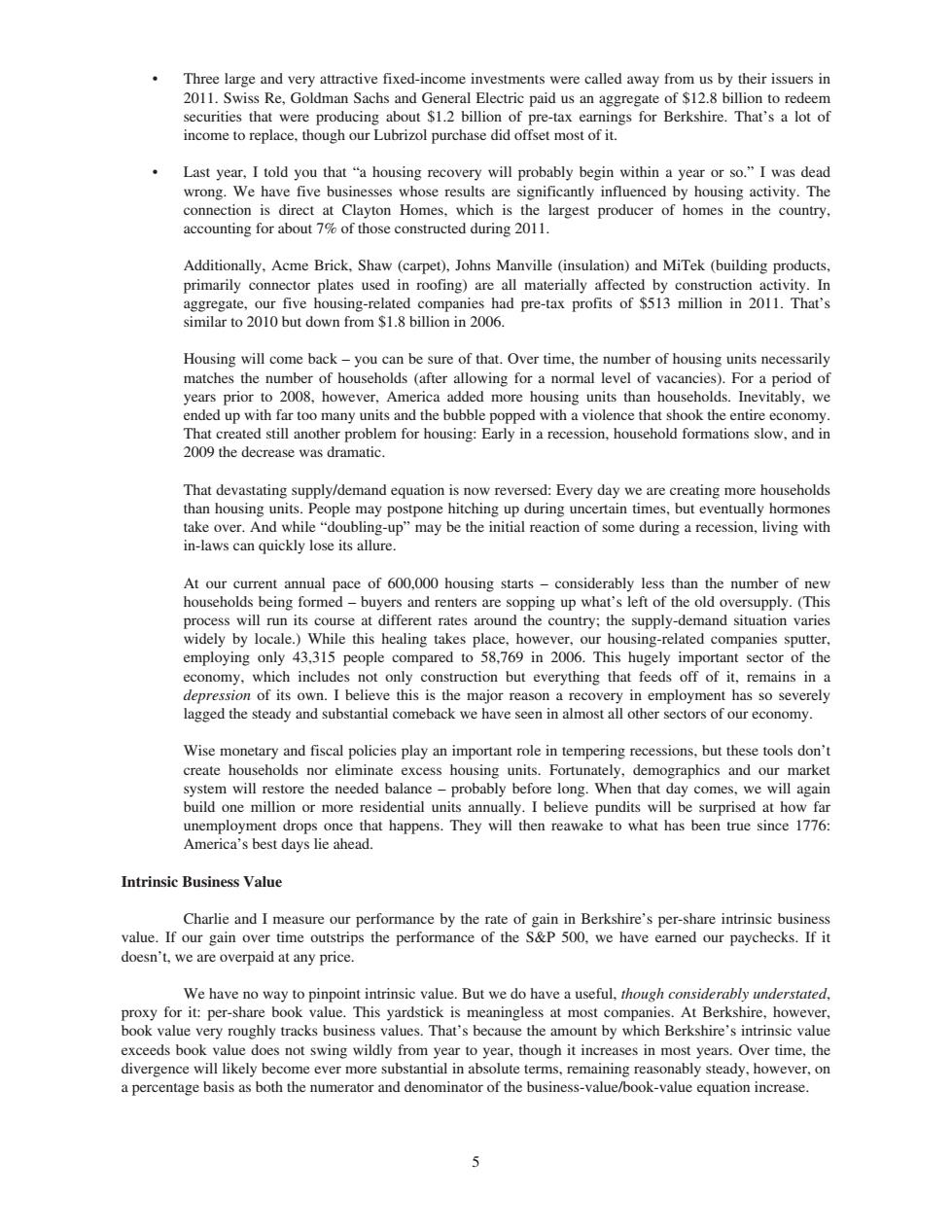正在加载图片...

securities that wer incm to repace.thoughourLubrizol purchasedidoffsetos Last yea was dead connection is direct at Clayton Homes.which is the largest producer of homes the ou accounting for about7%of those constructed during 2011. Additionally.Acme Brick.Shay )Johns Manville (insulatior and MiTek (building pro all p agg te.our five housing-related companies had pre-tax profits of $513 million in 2011.That's similar to 2010 but down from S1.8 billion in 2006. Hou ing will come hack- years prior to 2008.however.America added more housing units than households.Inevitably.we ended up with 心 That devastating supply/demand equation is now reversed:Every day we are creating more households People may hit considerably less than the number of ne s left of the old ove supply.(Thi widely by locae While this healing takes place.however.our housing-related companies sputter employing only 43.315 people compared to 58.769 in 2006.This hugely important sector of the economy,which includ not onl y construction but everything that feeds off of it,remains in a own. stantiat this as so seve Wise monetary and fiscal policies play an important role in tempering recessions,but these tools don't create ho iseholds e excess ho raphics and our mark ally. will b com rised at how fa unemployment drops once that happens.They will then reawake to what has been true since 1776 America's best days lie ahead. Intrinsic Business Value Charlie and I measure our performance by the rate of gain in Berkshire's per-share intrinsic business value.If our gain over time outstrips the performance of.we have eamed our paychecks.Ifit L we are overpald at any pnce We have no way to pinpoint intrinsic value.But we do have a useful.though considerably understated. proxy for it:per-shar hly tracks busin timer.on a percentage basis as both the numerator and denominator of the business-value/book-value equation increase.• Three large and very attractive fixed-income investments were called away from us by their issuers in 2011. Swiss Re, Goldman Sachs and General Electric paid us an aggregate of $12.8 billion to redeem securities that were producing about $1.2 billion of pre-tax earnings for Berkshire. That’s a lot of income to replace, though our Lubrizol purchase did offset most of it. • Last year, I told you that “a housing recovery will probably begin within a year or so.” I was dead wrong. We have five businesses whose results are significantly influenced by housing activity. The connection is direct at Clayton Homes, which is the largest producer of homes in the country, accounting for about 7% of those constructed during 2011. Additionally, Acme Brick, Shaw (carpet), Johns Manville (insulation) and MiTek (building products, primarily connector plates used in roofing) are all materially affected by construction activity. In aggregate, our five housing-related companies had pre-tax profits of $513 million in 2011. That’s similar to 2010 but down from $1.8 billion in 2006. Housing will come back – you can be sure of that. Over time, the number of housing units necessarily matches the number of households (after allowing for a normal level of vacancies). For a period of years prior to 2008, however, America added more housing units than households. Inevitably, we ended up with far too many units and the bubble popped with a violence that shook the entire economy. That created still another problem for housing: Early in a recession, household formations slow, and in 2009 the decrease was dramatic. That devastating supply/demand equation is now reversed: Every day we are creating more households than housing units. People may postpone hitching up during uncertain times, but eventually hormones take over. And while “doubling-up” may be the initial reaction of some during a recession, living with in-laws can quickly lose its allure. At our current annual pace of 600,000 housing starts – considerably less than the number of new households being formed – buyers and renters are sopping up what’s left of the old oversupply. (This process will run its course at different rates around the country; the supply-demand situation varies widely by locale.) While this healing takes place, however, our housing-related companies sputter, employing only 43,315 people compared to 58,769 in 2006. This hugely important sector of the economy, which includes not only construction but everything that feeds off of it, remains in a depression of its own. I believe this is the major reason a recovery in employment has so severely lagged the steady and substantial comeback we have seen in almost all other sectors of our economy. Wise monetary and fiscal policies play an important role in tempering recessions, but these tools don’t create households nor eliminate excess housing units. Fortunately, demographics and our market system will restore the needed balance – probably before long. When that day comes, we will again build one million or more residential units annually. I believe pundits will be surprised at how far unemployment drops once that happens. They will then reawake to what has been true since 1776: America’s best days lie ahead. Intrinsic Business Value Charlie and I measure our performance by the rate of gain in Berkshire’s per-share intrinsic business value. If our gain over time outstrips the performance of the S&P 500, we have earned our paychecks. If it doesn’t, we are overpaid at any price. We have no way to pinpoint intrinsic value. But we do have a useful, though considerably understated, proxy for it: per-share book value. This yardstick is meaningless at most companies. At Berkshire, however, book value very roughly tracks business values. That’s because the amount by which Berkshire’s intrinsic value exceeds book value does not swing wildly from year to year, though it increases in most years. Over time, the divergence will likely become ever more substantial in absolute terms, remaining reasonably steady, however, on a percentage basis as both the numerator and denominator of the business-value/book-value equation increase. 5